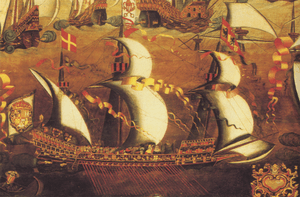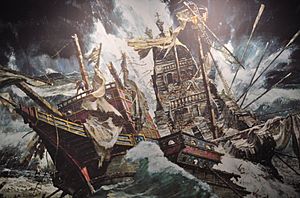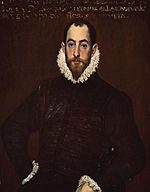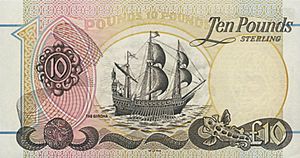Girona (ship) facts for kids

Galleass La Girona
|
|
Quick facts for kids History |
|
|---|---|
| Name | La Girona |
| Homeport | A Coruña |
| Fate | Wrecked 26 October 1588 |
| General characteristics | |
| Class and type | 50-gun galleass |
| Capacity | 1,300+ emergency loading |
| Troops | 186 transported |
| Complement | 531 sailors and rowers |
| Armament | 50 bronze and iron cannon |
| Notes | over 1300 aboard, 9 survived |

Wreck of the Girona (Ulster Museum Exhibit Painting)
|
|
La Girona was a large Spanish warship called a galleass. It was part of the famous Spanish Armada fleet in 1588. This ship sank off the coast of County Antrim, in Northern Ireland, on October 26, 1588. Many lives were lost, but later, amazing treasures were found from its wreck.
The ship was named La Girona after the Girones family. This family had recently become important Dukes and Viceroys in Naples. The ship's captain was Hugo de Moncada y Gralla, a knight of the Order of Malta.
Contents
The Shipwreck of La Girona

La Girona had anchored in Killybegs harbour, Donegal. Its rudder was damaged. An Irish chieftain, MacSweeney Bannagh, helped repair the ship.
On October 25, the ship set sail for Scotland. There were about 1,300 men on board. This included Alonso Martínez de Leyva, an important knight.
After passing Lough Foyle, a strong storm hit. La Girona was pushed onto rocks near Ballintoy in County Antrim. This happened on the night of October 26, 1588. These rocks later became known as the "Spanish Rocks."
Out of the estimated 1,300 people on board, only nine survived. About 260 bodies washed ashore. They were buried in a shared grave at the local churchyard.
The local clan leader, Sorley Boy MacDonnell, sent the survivors to Scotland. His home, Dunluce Castle, was close by. It stood on the Giant's Causeway cliffs. MacDonnell is also thought to have tried to recover items from the shipwreck first.
Finding the Treasures
Between 1967 and 1968, a team of Belgian divers found the remains of the wreck. This happened off the coast of Portballintrae. One of the divers was Robert Sténuit, the world's first aquanaut.
They brought up the largest collection of Spanish Armada treasures found up to that time. The underwater site was later protected by law on April 22, 1993.
Remembering La Girona
The sinking of La Girona is remembered on money in Northern Ireland. An illustration of the shipwreck is on the back of some sterling banknotes. These notes are issued by the First Trust Bank.
Treasures from the Girona Exhibit
Gold and silver coins, jewelry, weapons, and everyday objects from La Girona are on display. You can see them at the Ulster Museum in Belfast. This is a permanent exhibit.
-
Gold cross of a knight of Saint John of Jerusalem (Order of Malta), likely belonging to Hugo de Moncada y Gralla
See also
 In Spanish: La Girona para niños
In Spanish: La Girona para niños















